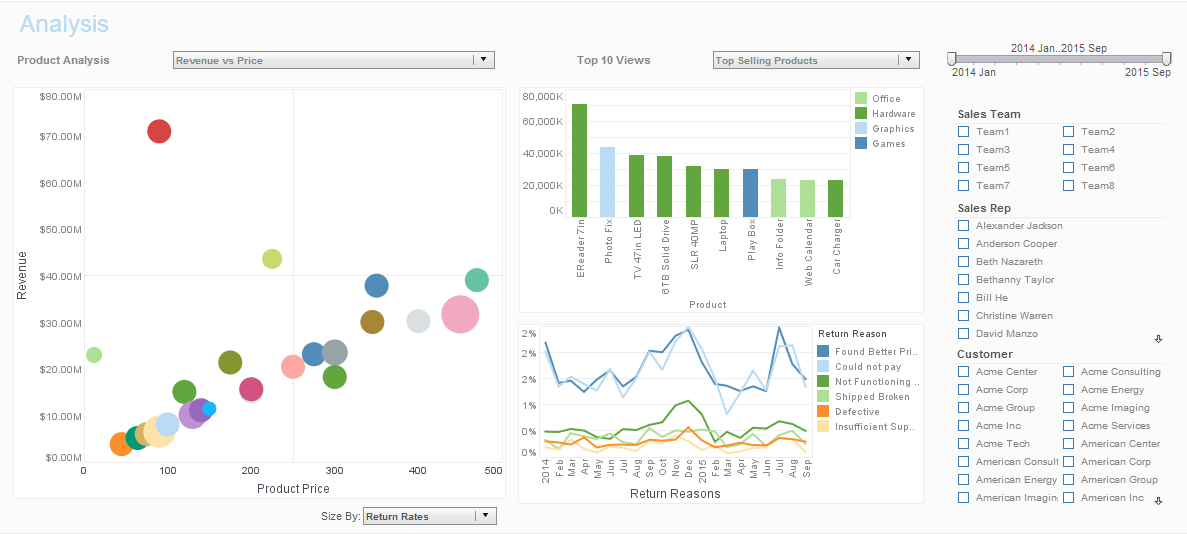InetSoft Product How-To: Create a Chart
Create a chart with InetSoft's free or commercial charting tools. View a demo and try them for free.
Style Intelligence is a commercial business intelligence software package with Web-based chart generation, reporting, and real-time access to almost any data source.
LabelForm.setTextSpec(spec)
Specifies the label text attributes, such as color, font, format, etc.
Type
spec a TextSpec object
Example (Report or Viewsheet)
importPackage(inetsoft.graph)
importPackage(inetsoft.graph.element)
importPackage(inetsoft.graph.scale)
importPackage(inetsoft.graph.aesthetic)
importPackage(inetsoft.graph.data)
importPackage(inetsoft.graph.coord)
importPackage(inetsoft.graph.guide.form)
var arr = [["State", "Quantity"], ["NJ", 200], ["NY", 300]];
dataset = new DefaultDataSet(arr);
graph = new EGraph();
var elem = new IntervalElement("State", "Quantity");
var form = new LabelForm();
form.setLabel("label1");
form.setValues(['NY', 100]);
var spec = new TextSpec();
spec.setColor(new java.awt.Color(0xff0000));
form.setTextSpec(spec);
graph.addForm(form);
graph.addElement(elem);
LabelForm.setTuple(value)
Specifies the point in logical space for the label text. The coordinates of the point are relative to the prevailing axis scaling.
Type
value An [X,Y] pair
Example (Report or Viewsheet)
importPackage(inetsoft.graph)
importPackage(inetsoft.graph.element)
importPackage(inetsoft.graph.scale)
importPackage(inetsoft.graph.aesthetic)
importPackage(inetsoft.graph.data)
importPackage(inetsoft.graph.coord)
importPackage(inetsoft.graph.guide.form)
var arr = [["State", "Quantity"], ["NJ", 200], ["NY", 300]];
dataset = new DefaultDataSet(arr);
graph = new EGraph();
var elem = new IntervalElement("State", "Quantity");
var form = new LabelForm();
form.setLabel("label1");
form.setTuple([0, 100]);
graph.addForm(form);
graph.addElement(elem);
LabelForm.setvalues(value)
Specifies the location of the label text using coordinate values, numeric or categorical. The coordinates of the point are relative to the prevailing axis scaling. So, for a categorical X-axis (e.g., 'NJ', 'NY', 'PA', etc.), the X-value of setValues should specify a categorical value (e.g., 'NJ').
Type
value an [X,Y] pair
Example (Report or Viewsheet)
importPackage(inetsoft.graph)
importPackage(inetsoft.graph.element)
importPackage(inetsoft.graph.scale)
importPackage(inetsoft.graph.aesthetic)
importPackage(inetsoft.graph.data)
importPackage(inetsoft.graph.coord)
importPackage(inetsoft.graph.guide.form)
var arr = [["State", "Quantity"],["NJ", 200],["NY", 300]];
dataset = new DefaultDataSet(arr);
graph = new EGraph();
var elem = new IntervalElement("State", "Quantity");
var form = new LabelForm();
form.setLabel("label1");
form.setValues(['NY', 100]);
graph.addForm(form);
graph.addElement(elem);
TagForm
The TagForm object contains information for a tag form. A tag is a label that is associated with a particular object and is automatically positioned to avoid other objects.
To create a TagForm object, call the TagForm constructor:
var tag = new TagForm();
Example (Report or Viewsheet)
importPackage(inetsoft.graph)
importPackage(inetsoft.graph.element)
importPackage(inetsoft.graph.scale)
importPackage(inetsoft.graph.aesthetic)
importPackage(inetsoft.graph.data)
importPackage(inetsoft.graph.coord)
importPackage(inetsoft.graph.guide.form)
var arr = [["State","Quantity"],["NJ",200],["NY",300],
["NY",305]];
dataset = new DefaultDataSet(arr);
graph = new EGraph();
var elem = new PointElement("State", "Quantity");
var form1 = new TagForm();
var form2 = new TagForm();
form1.setLabel("label1");
form1.setValues(['NY', 300]);
form2.setLabel("label2");
form2.setValues(['NY', 305]);
graph.addForm(form1);
graph.addForm(form2);
graph.addElement(elem);
ShapeForm.setAlignmentX(value)
Specifies the horizontal alignment of the shape with respect to the specified X position.
Values
GraphConstants.LEFT_ALIGNMENT GraphConstants.CENTER_ALIGNMENT GraphConstants.RIGHT_ALIGNMENT
Example (Report or Viewsheet)
importPackage(inetsoft.graph)
importPackage(inetsoft.graph.element)
importPackage(inetsoft.graph.scale)
importPackage(inetsoft.graph.aesthetic)
importPackage(inetsoft.graph.data)
importPackage(inetsoft.graph.coord)
importPackage(inetsoft.graph.guide.form)
var arr = [["State","Quantity"], ["NJ",200], ["NY",300]];
dataset = new DefaultDataSet(arr);
graph = new EGraph();
var elem = new IntervalElement("State", "Quantity");
var shape1 = new ShapeForm();
var shape2 = new ShapeForm();
shape1.setPoint(new java.awt.geom.Point2D.Double(.5,.75));
shape1.setShape(GShape.FILLED_TRIANGLE);
shape1.setColor(java.awt.Color(0xff0000));
shape1.setSize(new java.awt.Dimension(20,20));
shape1.setAlignmentX(GraphConstants.LEFT_ALIGNMENT);
shape2.setPoint(new java.awt.geom.Point2D.Double(.5,.5));
shape2.setShape(GShape.FILLED_TRIANGLE);
shape2.setColor(java.awt.Color(0x000000));
shape2.setSize(new java.awt.Dimension(20,20));
shape2.setAlignmentX(GraphConstants.CENTER_ALIGNMENT);
graph.addForm(shape1);
graph.addForm(shape2);
graph.addElement(elem);
ShapeForm.setAlignmentY(value)
Specifies the vertical alignment of the shape with respect to the specified Y position.
Values
GraphConstants.TOP_ALIGNMENT GraphConstants.MIDDLE_ALIGNMENT GraphConstants.BOTTOM_ALIGNMENT
Example (Report or Viewsheet)
importPackage(inetsoft.graph)
importPackage(inetsoft.graph.element)
importPackage(inetsoft.graph.scale)
importPackage(inetsoft.graph.aesthetic)
importPackage(inetsoft.graph.data)
importPackage(inetsoft.graph.coord)
importPackage(inetsoft.graph.guide.form)
var arr = [["State","Quantity"], ["NJ",200], ["NY",300]];
dataset = new DefaultDataSet(arr);
graph = new EGraph();
var elem = new IntervalElement("State", "Quantity");
var shape1 = new ShapeForm();
var shape2 = new ShapeForm();
shape1.setPoint(new java.awt.geom.Point2D.Double(.6,.5));
shape1.setShape(GShape.FILLED_TRIANGLE);
shape1.setColor(java.awt.Color(0xff0000));
shape1.setSize(new java.awt.Dimension(20,20));
shape1.setAlignmentY(GraphConstants.TOP_ALIGNMENT);
shape2.setPoint(new java.awt.geom.Point2D.Double(.5,.5));
shape2.setShape(GShape.FILLED_TRIANGLE);
shape2.setColor(java.awt.Color(0x000000));
shape2.setSize(new java.awt.Dimension(20,20));
shape2.setAlignmentY(GraphConstants.MIDDLE_ALIGNMENT);
graph.addForm(shape1);
graph.addForm(shape2);
graph.addElement(elem);
ShapeForm.setPoint(value)
Specifies the pixel location or proportional location where the shape is placed. (Positive values specify distance from left/bottom. Negative values specify distance from right/top.)
Type
value a subclass of java.awt.geom.Point2D e.g., java.awt.Point for pixels java.awt.geom.Point2D.Double for proportion
Example (Report or Viewsheet)
importPackage(inetsoft.graph)
importPackage(inetsoft.graph.element)
importPackage(inetsoft.graph.scale)
importPackage(inetsoft.graph.aesthetic)
importPackage(inetsoft.graph.data)
importPackage(inetsoft.graph.coord)
importPackage(inetsoft.graph.guide.form)
var arr = [["State","Quantity"], ["NJ",200], ["NY",300]];
dataset = new DefaultDataSet(arr);
graph = new EGraph();
var elem = new IntervalElement("State", "Quantity");
var shape1 = new ShapeForm();
var shape2 = new ShapeForm();
// Set shape1 points in pixels:
shape1.setPoint(new java.awt.Point(150, 100));
shape1.setShape(GShape.FILLED_TRIANGLE);
shape1.setColor(java.awt.Color(0xff0000));
shape1.setSize(new java.awt.Dimension(10,10));
// Set shape2 points proportionally:
shape2.setPoint(new java.awt.geom.Point2D.Double(.5,.5));
shape2.setShape(GShape.FILLED_TRIANGLE);
shape2.setColor(java.awt.Color(0xff0000));
shape2.setSize(new java.awt.Dimension(20,20));
graph.addForm(shape1);
graph.addForm(shape2);
graph.addElement(elem);


